
Amblyptilia epotis is a moth of the family Pterophoridae. It is endemic to New Zealand and is found in the South and Stewart Islands. It inhabits mountainous terrain covered in alpine vegetation or alternatively alpine wetland habitat. The adults of this species are on the wing from February to March. In appearance the adults of this species are variable in colour however this species can be distinguished from similar species by the oblique apical streak on its forewings as well as the patch of white on the costa cilia towards the apex of the forewing.
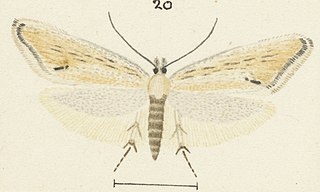
Glyphipterix necopina is a species of sedge moth in the genus Glyphipterix. It is endemic to New Zealand. It is classified as Not Threatened by the Department of Conservation.

Ichneutica scutata is a moth of the family Noctuidae. It is endemic to New Zealand. This species can be found in the southern parts of the North Island as well as the eastern parts of the South Island. It is similar in appearance to I. insignis and I. skelloni but can be distinguished as I. scutata is much paler in appearance. It is likely this species inhabits lowland tussock grasslands as well as coastal dunes although it is not common in inland tussock grasslands. The larvae feed on a variety of herbaceous plants such as Plantago and Convolvulus species, Plagianthus divaricatus. It pupates on soil near its host plants. The adults are on the wing from late March to July.
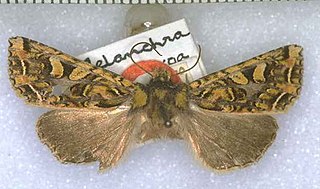
Meterana tetrachroa is a species of moth of the family Noctuidae. This species is endemic to New Zealand. It is classified as "Data Deficient" by the Department of Conservation.
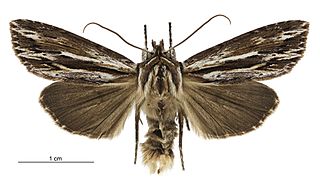
Ichneutica similis is a moth of the family Noctuidae. It is endemic to New Zealand. This species is found only in certain parts of the North Island, in the western side of the South Island and on Stewart Island. It inhabits peatlands as well as inland and coastal wetlands. The life history of this species is unknown and the host species of its larvae has yet to be confirmed. It has been hypothesised that larval host species might be within the Empodisma genus as well as possibly the species Apodasmia similis.

Phaeosaces lindsayae is a species of moth in the family Depressariidae. It is endemic to New Zealand. It is classified as "Data Deficient" by the Department of Conservation.
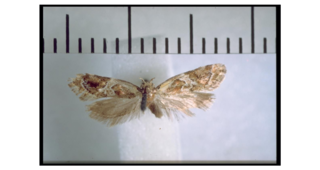
Trachypepla roseata is a species of moth in the family Oecophoridae. This species is endemic to New Zealand and is found in the Nelson and Tasman regions of the South Island. It frequents forest habitat and is on the wing in January. It is classified as "Data Deficient" by the Department of Conservation.

Eutorna inornata is a moth in the family Depressariidae. It was described by Alfred Philpott in 1927. It is endemic to New Zealand and has been observed in both the North and South Islands. The larvae of this moth are leaf miners of Selliera radicans.

Asaphodes albalineata is a species of moth in the family Geometridae. It is endemic to New Zealand and has been observed on Stewart Island / Rakiura. This species is similar in appearance to Asaphodes oraria but can be distinguished as it has an unusual pattern on the underside of its hindwings. It inhabits open hill tops and adults are on the wing in December.

Ichneutica averilla is a moth of the family Noctuidae. It is endemic to New Zealand. This species is found in the North Island at Mount Taranaki but is widespread throughout the South Island and Stewart Island. It prefers mountainous habitat but can be found down to sea level in the southern parts of the South Island. Adults of the species are on the wing between November and March. Larvae likely exist on a variety of herbaceous plants but have been recorded as feeding on species within the genus Plantago. This species is sometimes confused with I. mutas but can be distinguished from the latter on the basis of forewing colour as well as the absence of or an indistinct antemedian forewing line.

Sagephora jocularis is a species of moth in the family Tineidae. It was described by Alfred Philpott in 1926. This species is endemic to New Zealand and has been collected in Canterbury and Southland. Adults are on the wing in January and October.

Meterana exquisita is a species of moth in the family Noctuidae. This species is endemic to New Zealand. It is classified as "At Risk, Relict'" by the Department of Conservation.
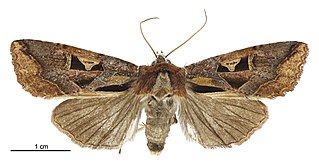
Meterana grandiosa is a species of moth in the family Noctuidae. This species is endemic to New Zealand. It is classified as "At Risk, Relict'" by the Department of Conservation.

Ichneutica panda is a species of moth in the family Noctuidae. It is endemic to New Zealand and only found in central and southern parts of the South Island. The species has not been collected in Canterbury since the late 1950s and has not been seen at The Wilderness scientific reserve since 1941. This species is similar in appearance to Ichneutica falsidica however I. panda lack or have indistinct black dashes on their edge of their hindwings. I. panda inhabit shrubland from alpine zones down to river terraces and adults are on the wing between December and February. The life history of this species is unknown as is the host species of the larvae.
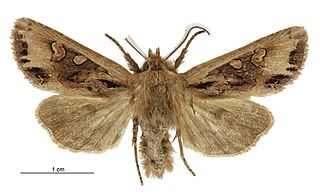
Ichneutica fenwicki is a moth of the family Noctuidae. This species is endemic to New Zealand and is found in the southern parts of the South Island and on Stewart Island. It is a distinctively coloured moth that is unlikely to be confused with closely related species. It is a spring flying moth being on the wing from September to November. The life history and host species of the larvae of I. fenwicki are unknown.

Mallobathra cana is a moth of the family Psychidae. This species is endemic to New Zealand.
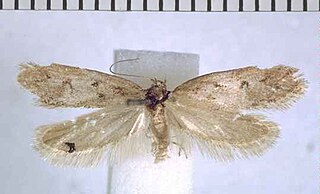
Tingena honesta is a species of moth in the family Oecophoridae. It is endemic to New Zealand and can be found in the South Island.

Tingena morosa is a species of moth in the family Oecophoridae. It is endemic to New Zealand and has been found in the South Island in Nelson including at the Dun Mountain and in the Canterbury region. This species inhabits native forest at altitudes from 2000 to 3000 ft. Adults of this species are on the wing in December.

Tingena opaca is a species of moth in the family Oecophoridae. It is endemic to New Zealand and has been observed in the southern parts of the South Island. Adults of this species are on the wing in December.

Pseudocoremia insignita, also referred to by the common name tree nettle flash, is a species of moth in the family Geometridae. It is endemic to New Zealand.




















